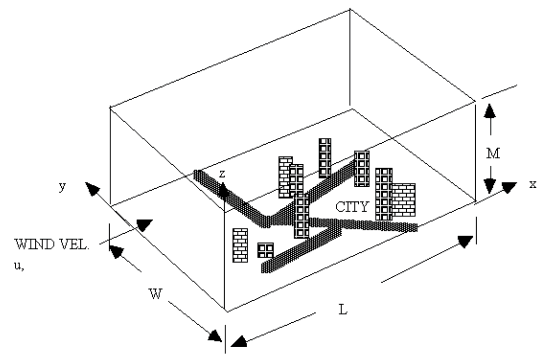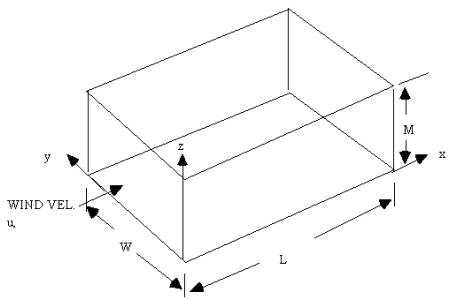| Fixed Box Models | |
|
|
|
 |
Consider a rectangular city with a rectangular plan. Width = W
And thus area = WL = A Wind blows parallel to long side in direction x. |
| Now let us assume that: | |
 |
|
|
1) Atmospheric turbulence mixes pollutants completely up to mixing height M but above M no mixing takes place. 2) Turbulence in upwind direction is enough to give a uniform distribution within the "box".
3) Wind velocity u is constant and always in direction x. also untrue but again, it makes the mathematics "user friendly".
4) The concentration of pollution in air entering the "box" at x=0 is constant and equal to b (background concentration). Most models operate in µg/m3 but any suitable units are acceptable. 5) Air pollution emission rate Q is constant. This may also be given in terms of emission rate per unit area q. q = Q/A. Consider for yourself now the relationship between the units of q and Q and the units f the concentration we are measuring. 6) No pollutant enters or leaves through top of box nor through the sides parallel to wind direction. 7) The pollutant is conservative i.e. the destruction rate is zero within the time frame of the pollutant's life within the box. Volume of system = WLM Since all flows into and out of the box are constant we have a steady state and thus
We consider the "emission rate " Q as a flow rate in from the lower face. Thus |
|
 |
|
INWARD FLOWS?There are two pollutant flows into the box: Inward flow from upwind of the box = uWMb (units mass/unit time) Inward flow from the lower face = Q = qWL OUTWARD FLOWS?Since we are at steady state the concentration in the 'box' is a constant c and the only outward flow is the flow out of the downwind face. Flow out of the box = uWMc. Thus uWMb+qWL-uWMc = 0 uWMc=uWMb+qWL uMc=uMb+qL c = (uMb/uM)+(qL/uM) c=b+(qL/uM) Note that W does not enter the calculation but clearly the upwind concentration b is additive to concentration produced by city (for the long-lived pollutants we are considering). Concentration increases with q and L and decreases with u and M. What does this tell us about the best design of a city for least pollution? |
|
 |
|
 |
|